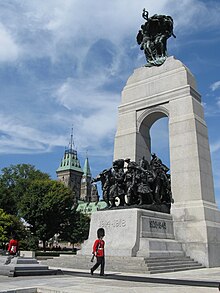National War Memorial (Canada)
The National War Memorial ( English National War Memorial , French Monument commémoratif de guerre ) on Confederation Square in Ottawa is a central Canadian memorial to the 116,000 fallen soldiers and other people in the service of national defense during the First World War and all subsequent wars.
history
In 1925, a competition was announced for a memorial to commemorate the First World War. In January 1926, the English sculptor Vernon March received the commission from 127 submissions . March described the basic idea of his monument in the following words:
"The idea was to perpetuate in this bronze group the people of Canada who went Overseas to the Great War, and to represent them, as we of today saw them, as a record for future generations ..."
"The idea was to immortalize in this bronze group those people of Canada who went overseas into the First World War, and to represent them as we see them today as memories for future generations ..."
Work on the bronze sculpture began in March's workshop in 1926. After March's death in 1930, his six brothers and a sister completed the work in 1932. Until they were displayed in Ottawa, the figures were part of a biannual exhibition in London's Hyde Park . The order for the triumphal arch took place in December 1937. The material of the arch and the underlying pedestal in the form of a mock grave consists of gray-pink-colored granite from the Dumas Quarry mining site in Rivière-à-Pierre (Québec). A total of 503 tons of granite and 32 tons of bronze were used in the monument .
March placed 22 bronze sculptures on a pedestal under an approximately 21 meter high triumphal arch, crowned by the 5.33 meter high allegories of peace and freedom . The men and women depicted are all approximately 2.40 meters high. Starting from the left with two infantry soldiers in original uniforms from the First World War, one with a Vickers machine gun in hand, the next with a Lewis gun , the pilot , aircraft mechanic and marine follow . The whole series of figures ends with a nurse , lumberjack and paramedic . Two horses protrude from the series of figures. All of the people shown are directly or indirectly involved in the war and march or move under the triumphal arch. The task was to portray all these people in such a way that they would not glorify the war.
On May 15, 1939, King George VI. the monument. in front of an estimated crowd of 100,000 people. Added to the numbers World War II (1939–1945), Korean War (1950–1953) in 1982, Prime Minister Stephen Harper announced in 2014 that the Afghan War will be honored with the numbers (2003–2013) on the memorial. In 2000, a twelve foot long, eight foot wide and three foot high sarcophagus was added to the ensemble , in which the remains of an unknown Canadian soldier who took part in the Battle of Vimy Ridge are buried .
Incidents
- On July 2, 2006, the day after the national holiday , an incident occurred in front of the memorial. A group of young people was photographed urinating in front of the memorial.
- On October 22, 2014, Michael Zehaf-Bibeau shot and killed the soldier Nathan Cirillo who was on duty at the memorial. As a result, there were more shootings in the city.
Web links
Individual evidence
- ↑ Veterans Affairs Canada: The National War Memorial, October 25, 2014, accessed October 25, 2014
- ↑ Veterans Affairs Canada: The National War Memorial, October 25, 2014, accessed October 25, 2014
- ↑ Heilbronn voice : Ottawa attackers sought contact with Islamists from October 25, 2014, accessed on October 26, 2014
Coordinates: 45 ° 25 ′ 26.5 " N , 75 ° 41 ′ 43.8" W.
